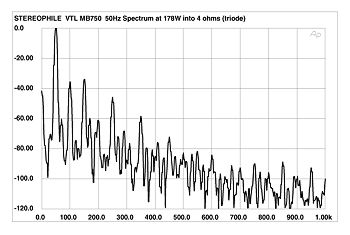| Columns Retired Columns & Blogs |
VTL MB750 monoblock power amplifier Measurements part 3
The 50Hz distortion spectrum is shown in fig.7. The distortion level is relatively high, though not for a tube amplifier operating at such a high level. The second harmonic (100Hz) is at -35dB (about 1.7%), the third at -34dB (about 2%). The spectral analysis of the IM distortion resulting from the combination of 19kHz and 20kHz tones is shown in fig.8. Here, the IM at the 1kHz difference tone at 1kHz is -28dB (about 4%). Again, this is a relatively high figure, but the output power here is 122W.

VTL MB-750, triode mode, spectrum of 50Hz sinewave, DC-1kHz, at 178W into 4 ohms (linear frequency scale).

VTL MB-750, triode mode, HF intermodulation spectrum, DC-22kHz, 19+20kHz at 122 W into 4 ohms (linear frequency scale).
The THD+noise vs output power (1kHz) curves are shown in figs.9 and 10; Table 1 lists the discrete clipping levels (using 3% THD+noise as a clipping point).

VTL MB-750, triode mode, distortion (%) vs output power into (from bottom to top): 8 ohms, 4 ohms, 2 ohms.

VTL MB-750, tetrode mode, distortion (%) vs output power into (from bottom to top): 8 ohms, 4 ohms, 2 ohms.
| Table 1 VTL MB-750 Clipping (3% THD+noise at 1kHz) | ||
| Triode W (dBW) | Tetrode W (dBW) | |
| 8 | 236 (23.7) | 426 (26.3) |
| (line) | 115V | 117V |
| 4 | 266 (21.2) | 454 (23.6) |
| (line) | 115V | 116V |
| 2 | 65 (12.1) | 56 (11.5) |
| (line) | 114V | 117V |
While the MB-750 is undeniably a powerful amplifier, our sample did fall noticeably short of its rated power at a reasonable distortion level—though at a voltage level closer to 120V, the power output in triode mode increased by about 10% from the above values. Still, most users are unlikely to hear any audible power limitation, even in triode mode.
The VTL MB-750's test-bench results, though not exceptional, are more than respectable for a very-high-power tube amplifier.—Thomas J. Norton
- Log in or register to post comments



































